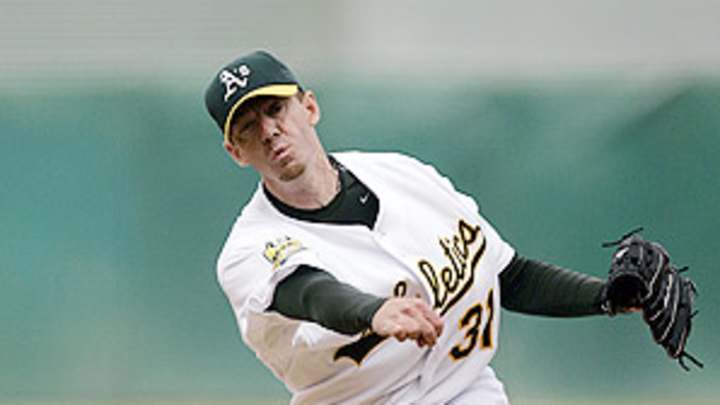Scouting Report: Brad Ziegler, Oakland A's


Latest in a series of scouting reports provided to SI.com by the network of former scouts, executives, players and coaches at the Baseline Group.
Current: Average
Projected: Average
Categorization Scale:
• Elite: Mariano Rivera
• Premium: Billy Wagner
• Good: Francisco Cordero
• Average: Brandon Lyon
• Key role: Ron Villone
Ziegler is a submarine pitcher who relies on his deceptive angle and command to get hitters out. The 28-year-old pitched well last year -- his first as a dedicated reliever -- between Oakland's Double-A and Triple-A teams, posting a 2.41 ERA with 62 strikeouts, 18 walks and no home runs allowed in 78.1 innings.
Since his call-up to the A's in late May, Ziegler has pitched better than anyone could have imagined. Through August 12, Ziegler had posted this amazing line:
• Games: 29
• Innings: 38.0
• Hits: 21
• Walks: 11
• Strikeouts: 17
• ERA: 0.00
Prior to his call-up, Ziegler had allowed just one earned run in 24.1 innings for Triple-A Sacramento. So for the year, he's allowed one earned run in 62.1 innings. Amazing!
Though Ziegler has below average stuff, he's been able to succeed because of his deception and ability to keep the ball down and out of the middle of the plate.
1. Will batters catch up to him?
Yes, eventually, they'll catch up to him, meaning they'll hit better against him at some point in the future than they are right now. After all, he can't keep this pace up forever. The better question is how much will they catch up to him? There's no way to know for sure now, but we'll have a better idea in September. The A's play a lot of games against their AL West rivals that month, giving opposing hitters more opportunity to see him and adjust to his pitching style.
2. Why at age 28 is Ziegler suddenly having this success?
It's a combination of things:
• This is just his second year as a reliever, and he did well in his first between stops at Oakland's Double-A and Triple-A affiliates.
• Maturity. Some guys are late bloomers and need to mature mentally, emotionally and physically before they achieve success. Ziegler may be one of those guys.
• Deception. Not many pitchers throw from his angle, thus hitters have to make a major adjustment to hitting him. Since Ziegler is a reliever and doesn't throw many innings, it's difficult for hitters to get enough exposure to him to make the proper adjustment.
3. Can Ziegler be a closer with such a low strikeout rate?
Yes. Typically you want your closer to have a swing and miss pitch, which Ziegler doesn't. But Ziegler keeps the ball in the park (he hasn't allowed a home run since 2006) and he's got good control -- two things you want for a closer.
4. If you're an opposing manager, how do you have your hitters attack Ziegler?
You need good scouting. You need to know his tendencies, especially for first pitch location. He tends to be aggressive with his fastball and throw early strikes. He also keeps the ball off the middle of the plate and keeps it low. So, one approach would be to anticipate a first pitch low fastball and look on one half of the plate. If your hitters demonstrate the tendency to sit on the low fastball, Ziegler will need to adjust by elevating the ball, where his pitches aren't that effective.
5. Will he tire?
Though Ziegler has pitched as many as 163 innings in a season (2006 when he was a starter), he's quickly approaching last year's total of appearances (50 in 2007 versus 48 in 2008) and innings pitched (78.1 in 2007 versus 62.1 in 2008). At his current pace, he'll end the year with 65 appearances and 88.1 innings.
6. How will he react to adversity?
Since Ziegler has yet to give up a run for Oakland, he hasn't had to deal with adversity. We'll only have a comprehensive understanding of Ziegler as a pitcher after he has failed and we can see how he reacts. He's pitching with a ton of confidence and aggressiveness right now, but after he blows a save or two can he continue pitching the same way?
• Deceptive angle
• Natural sinking action
• Above average command
• Confident and aggressive
• Below average fastball velocity
• Below average curveball
• Movement: Natural sinking and tailing action to both sides of the plate.
• Command: Above average. He's shown the ability to locate to both sides of the plate and more importantly to consistently pitch down in the zone.
• Plan: Although he has below average velocity, Ziegler is still able to pitch aggressively and goes right after the hitter.
• Movement: Big sweeping break with limited depth.
• Command: Average. He'll locate this best to his glove side of the plate but will use it to his arm side. When he does throw it arm side, he will at times leave it in the middle of the zone.
• Plan: He picks his spots well when he throws his curve. He uses it more as a show pitch in an attempt to change the hitter's timing.
Ziegler is an average to slightly above average defender. He's able to move off the mound and field his position. He is above average with his release times to the plate and has a good move to first. Release time range to first: 1.22 to 1.29. Release time to second: 1.25 to 1.39 seconds.
